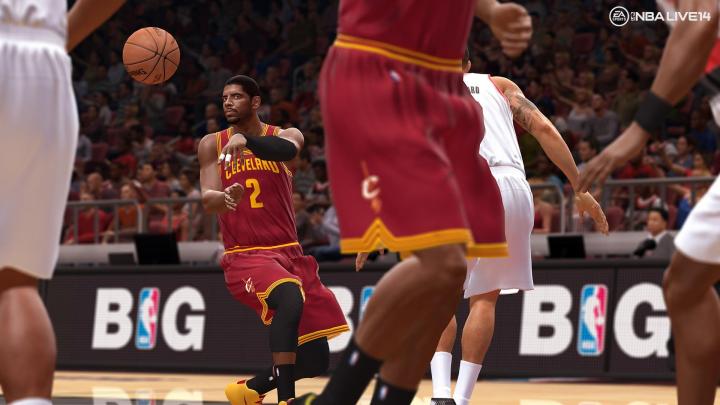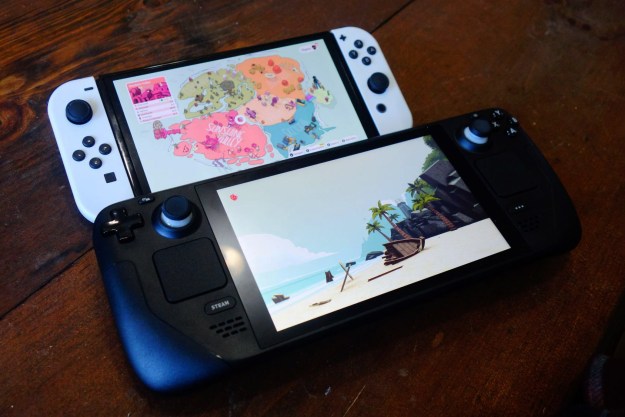
No one envies the spot EA Sports’ Tiburon team is in with NBA Live 14. The twice-cancelled, long-absent pro basketball sim finally hits the courts in 2013 after a pair of near-releases in 2010 and 2012. The upcoming game, launching on November 19 as a next-gen exclusive for PlayStation 4 and Xbox One, has a lot of expectations riding on it. How will EA Tiburon differentiate this new game from its chief competitor, NBA 2K14? What can NBA Live offer that brings something fresh to pro basketball sims?
Story/Concept
Hit the courts. Just like many other professional sports simulation, there’s no narrative other than the one you build for your player or your team on the court in NBA Live 14. The game’s new Rising Star mode gives you the opportunity to create a fresh player and run through his 25-season career. We didn’t get to see this mode in action, but it keeps you locked to the player you’ve created – complete with custom, zoomed-in camera angles specific to Rising Star – for every game. There’s no pre-draft interviews or press conferences, or any of the other role-play trappings that are increasingly common in other sports sims; it’s just your player and a long ladder to climb toward greatness.

A separate Dynasty Mode puts you in the GM’s seat, managing trades, free agent pickups, and the like, while also playing through any of the games that you choose to (simulation is always an option). We didn’t get to check this out either, but expect a similarly barebones, first-time-out presentation. Both of these modes (along with the others in the game) benefit from EA Tiburon’s partnership with Synergy Sports Technology, the company that tracks and logs NBA stats and team tendencies in real-time. This information will also be pushed to NBA Live 14 (provided you have an active Internet connection) within an hour after each game, affecting everything from individual player stats to the types of challenges you can take on (discussed below).
Capturing the big moments. In addition to the two franchise-focused modes, NBA Live 14 also updates regularly during the season with mini-challenges that are designed to capture memorable moments from each day’s games. Take Derrick Rose’s game-ending floater on Halloween that secured the Chicago Bulls a win over the New York Knicks with just 5.7 seconds left on the clock. It was Rose’s first home game since he injured his knee 18 months ago. On the NBA Live 14 side, that moment is realized as the “A Rosey Homecoming” challenge accessible from the main menu; fire it up and you get an opportunity to replicate the game-winning shot. Throughout the season, the list of available challenges will continue to grow. There’s no plan to take them down, so you’ll be able to return to them as often as you wish.
Gameplay
Baller ball handling. NBA Live 14 subscribes to the same philosophy that many other EA Sports titles do, of using the right analog stick as a more directly tactile interface within the game. In this particular case, the right stick tweaks how the ball carrier dribbles. Push back and to the left (based on the ball carrier’s orientation), and the bouncing ball will be directed behind the player’s back. For defensive maneuvers, push and hold the stick in the opposite direction you’re facing to keep the ball behind you in a more guarded stance. Cross left and right as you crash toward the net to whiz by defenders and sink a quick basket. It feels natural almost immediately, and somewhat similar in basic design to EA’s Pro Stick puck handling in the NHL series.

Your ability to move the ball around fits perfectly into the EA Sports philosophy. Much like the FIFA series, it’s simple enough to get a handle on that even a sports ignorant gamer can pick up a controller and catch on quickly.
More modes. The Rising Star and Dynasty modes may be at the heart of NBA Live 14, but there’s more. This year’s entry doesn’t include the Connected Franchise elements that have allowed more recent EA Sports offerings to take their dynasty modes online, but it does feature another fan favorite: Ultimate Team. You build a fantasy team of your own out of trading cards, beginning with a random assortment obtained from the free starter pack that all players receive the first time they fire up the mode. You then earn points as you play the mode that can be spent on additional packs (or, alternatively, you can spend real dollars to buy packs more quickly).
While Ultimate Team allows for online play, it’s not the only option. Head-to-Head is as straightforward as these things get: you take one team, your opponent takes the other. NBA Live 14 only allows for 1v1 games, so you won’t be able to completely fill out your squad with human players. There is a more elaborate competition mode, however, in “H2H Live Seasons.” Here, you participate in a 10-game season against other players, earning a ranking in your division when it’s all over. Depending on how you do, you either move up or down in the rankings to face more evenly skilled opponents on your next runthrough.
Presentation

Personal foul. NBA Live 14 isn’t a bad looking game, but it’s not nearly as polished as some of the other launch day competitors.The on-court reflections and general feel of the crowd work well enough, but players and coaches are filled out by relatively bland textures and good-not-great animations. It’s a forgivable offense for a series that’s been left hanging over a period of years; EA Tiburon scrapped two previous projects before coming to NBA Live 14, and as a result the studio had to focus its efforts on building an strong foundation. If you’re looking for a next-gen launch title that showcases the graphical power of your new console, this isn’t it.
ESPN-lite. What NBA Live 14 lacks in visual stopping power, it makes up for in terms of raw presentation. EA Sports hasn’t ever been afraid to leverage its ESPN partnership in unexpected ways, and this game’s halftime show – built to resemble SportsCenter, complete with a scrolling bar listing the top stories at the side of the screen – is a testament to that. What’s more, in addition to the two-man commentary team of Mike Breen and Jeff Van Gundy, Jalen Rose is on board as the studio and game host. We’re told that Rose is committed to delivering a weekly NBA Live update during which he’ll discuss roster moves, big games, and team/player narratives that spring up over the course of the season.

Music mix. Rounding out the presentation is a mix of music from Mick (also known as the DJ and mixtape composer Mick Boogie) that is worked into a dynamic soundtrack. Each mode comes with its own curated playlist, though you can mix the tracks up however you like as well. We spotted an assortment of up-and-comers like Diplo, Pusha T, and Major Lazer on the list, and we’re told that Mick will be adding more music in as the season goes on.
Takeaway
It’s easy to predict disaster for NBA Live 14 if you’re looking at what’s happened in the past as an indicator. The truth is, the game feels like a solid EA Sports production. It definitely needs to grow and evolve, and those looking for deep-dive features like designing your own sneakers and online seasons must turn elsewhere. But there’s a strong foundation here, built on gameplay that is simple and intuitive, even if you’re a basketball neophyte.
Look for NBA Live 14 in stores on November 19, 2013.
Editors' Recommendations
- EA Sports promises stronger measures against racism, particularly for NHL games
- EA will donate $1 million to coronavirus relief through FIFA tournament
- Electronic Arts hints at possible return to Steam, 8 years after Origin launch


